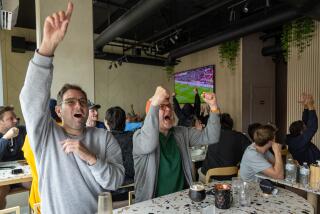L.A. a Leading Contender for World Cup Final
No sooner had the announcement been made in Switzerland Monday that the 1994 World Cup will be staged in the United States than the lobbying began to have the championship match played in Los Angeles.
Eighteen stadiums across the country have been nominated as potential World Cup sites, but the two being most prominently mentioned as the best location for the final are the Rose Bowl in Pasadena and Joe Robbie Stadium in Miami.
For the record:
12:00 a.m. July 6, 1988 For the Record
Los Angeles Times Wednesday July 6, 1988 Home Edition Sports Part 3 Page 3 Column 3 Sports Desk 1 inches; 15 words Type of Material: Correction
A reference to the age of the Coliseum in Tuesday’s editions of The Times was incorrect. It was built in 1923.
“Los Angeles is a natural,” said Tony Morejon, long-time local soccer promoter and president of the Greater Los Angeles Soccer League. “After what happened in the (1984) Olympic final, I think it’s the natural place.”
Added fellow promoter Hugo Bandi: “Joe Robbie is lobbying a lot for his stadium, but I personally think that the final and one semifinal belong on the West Coast. There’s more tradition here. We had the Olympics here. We’ve had (international) games with from 15,000 to 63,000 (spectators) here. I think that the Coliseum or the Rose Bowl should be the site.”
But the age of the two stadiums might act against them. The Rose Bowl was built in 1922, the Coliseum 10 years later.
“We don’t want a 1920-vintage stadium, we want a 1994 stadium,” Werner Fricker, president of the United States Soccer Federation, told The Times’ Randy Harvey in Zurich, Switzerland, last week.
Fricker added, somewhat contradictorily, that this would not necessarily preclude the Rose Bowl, where a U.S.-record soccer crowd of 101,799 attended the 1984 Olympic final between France and Brazil.
“It’s an interesting stadium,” Fricker said. “The playing surface is up to speed. We’ve had good attendance there before, and it’s in a part of the city that is attendance-conducive. I don’t think the fact that it’s older than some of the other stadiums hurts it at all.”
But Fricker described Joe Robbie Stadium, which seats 25,000 fewer than the Rose Bowl, as “really a 1994 stadium in every respect; it’s fabulous.”
“It’s going to be a very difficult decision to make,” he said. “Obviously, it’s going to be where FIFA (world soccer’s governing body) wants it to be.”
While reaction to Monday’s decision among local soccer followers and officials was positive, there were those who expressed a note of caution.
“I think it’s incumbent upon those of us who love soccer to build from what World Cup is going to provide for us,” said Tim Thompson, executive director of the 350,000-strong American Youth Soccer Organization.
The collapse of the North American Soccer League after its success in the mid-to-late 1970s is an example to be avoided, Thompson said. The World Cup will not by itself assure soccer’s future as a viable sport in the United States.
“I would think that we historically stand a good chance of stubbing our toes,” he said. “I think that we need to be very cautious and very conscious of the fact that that history (of failure) precedes this. We need to do everything we can to ensure that soccer goes forward after the World Cup and doesn’t slip again.”
Morejon, who has been involved in soccer in Los Angeles for a half-century, said he is concerned that the United States acts now to ensure that FIFA has no reason to regret its choice.
“I just hope we can make it,” he said. “I hope that FIFA doesn’t change its mind. One of the requirements, I understand, is that this country has to come up with a national professional league by 1990. I think we can do it if we get the people behind it. If we get a lot of the corporations behind it, it can be done.”
Bandi said such corporate sponsorship and backing already is starting to be felt.
“I think it (the World Cup) is going to give a boost to American soccer,” he said. “We need this like we needed Pele in the 1970s to help soccer in America.”
Morejon said the United States must begin today to build toward 1994.
“I hope that now we’ll give more exposure to American soccer, especially with the (U.S.) Olympic team playing in Korea,” he said. “We must make our national team stronger and make an extra effort to qualify for the 1990 World Cup in Italy. That’s very, very important. If we can qualify for 1990, people can’t say we had to wait to host it in order to get in it.”






